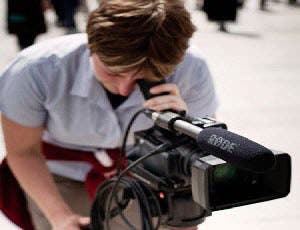A great deal of my work has involved showing up on location without prior scouting and with little direction from my client. That means it’s up to me to shoot enough of the right video so that I can be as flexible as possible in post. So I’ve developed a philosophy,or style, for these types of jobs.
Firstly, shoot wide. The wider, the better. My primary (no pun intended) lens is my Nikon 24mm f/1.4G lens. Use this lens 85-90% of the time. The reason? I like to get as close to the action as I can. The closer you can get to your subjects the more interactive your video will feel to your audience. Wide-angle lenses do this in two ways: exaggerate depth and distance and motion, and they give environmental context- meaning they show where you are. The second one sounds obvious, but too many people have forgotten about wide angle, deep depth-of-field shots ever since DSLR’s become the new videographers tool. If you want to get a bit closer, use a 35mm lens.

Side note- I my Nikon D800 gives me the option to shoot in FX (full-frame) or DX (APS-C) modes. That means I can switch between a 24mm and 35mm f1/1.4 lens just by pressing a button.
When I need to get in close, to shoot hands (hint, hint), I reach for my Nikon 50mm f1/1.8G. Everyone loves 50mm lenses and I’m no exception. This lens I use as a tight shot for interviews and over-the-shoulder shots. Again, I can switch back and forth between full-frame and APS-C crop modes so that 50mm lens can also be a 75mm lens.
Two lenses- four focal lengths. Travel light, and keep things simple.
The D800 isn’t known for its low-light performance, so I use an Atomos Ninja, so that even if I’m shooting at 1600, 2400, or even 3200 ISO I have enough information to run noise reduction and still get a good image.
I also have my D800 caged. I use a Wooden Camera DSLR cage equipped with a top handle as my main rig. It’s incredibly modular and I’ve created way too many variations of this setup to mention. I customize it for particular shoots, but the top handle is my main setup.
One of the frustrating things I’ve run into is the seeming lack of B-roll. Let’s face you will not always be filming the most exciting things- sometimes you have to film something, to be quite honest, boring. But you’re video can’t be boring so you need to find ways a making it interesting. And good B-roll can help you do this.
One of the best ways to make things more interesting is to shoot sequences.

A sequence is a simple concept. Two or more shots of an action cut together in sequence to tell a story. Sequences typically start with a wide (establishing) shot- this shows where the action is happening. This can be followed by a medium shot, which lets your audience see the subject. This is this, typically, followed by a close-up shot- show the subject’s face or hands (if they are doing something with them). You can then reverse the shot sequence or add a “creative” shot- this would be a shot from a strange angle, internal framing, or even Dutched (titling the camera on the lens axis).
I call this a, “story inside the story”.
But, you won’t always have much control over your environment. Sometimes you find the perfect shot only to realize that a chair, or sign, or even another person is ruining it. Here I like to apply one of Jo McNally’s principles- shoot a piece of it. Take that perfect shoot and then break it into pieces. The added bonus to this is that you can then cut between those “pieces” shots to create a sequence. This is also the time to get close, whether with or 24mm or 50mm, or maybe even a macro lens. I love my Nikon 105mm macro lens so I’m always looking for places to use it.

Lastly, try to capture something different. Even the most mundane of actions can be viewed from a different angle- try to find the thing that no one else has seen.
I love shooting interviews in someone’s office. Unlike someone’s home that is filled top to bottom with furniture, decoration, etc., offices are filled with precious trinkets and mementoes that reflect who the person is and what/who they care about. Use shots from around the office to liven up that person’s interview.

Finally, shoot the feet. Can’t think of another shot? Shoot the feet. One of my college professors told us this and it’s saved my neck more than a few times in the edit.




